Isabella Bradford's Blog, page 29
September 14, 2017
Fashions for September 1862
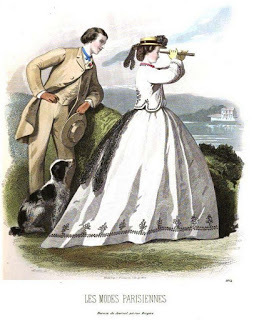 Seaside costume September 1862
Loretta reports:
Seaside costume September 1862
Loretta reports:Author Donna Hatch , whom I finally met in London, recently shared a post on crinolines, which I in turn shared on Facebook. You may want to look at this piece while you peruse this month’s fashions. You’ll note that this dress , from the Met Museum’s collection, which appears in the article, bears a resemblance to the image from Plate 2 of the magazine.
Description of Plates
SECOND PLATE.—First Toilette. Dress of white coutil embroidered in black. The embroidery in this style of; dress always affects the Greek style of ornament, is always based on a line and placed close to the hem. The Zouave jacket is much rounded, and embroidered in accordance with the skirt. Sleeves half-large, rounded, and open to the elbow. The chemisette and under-sleeves in strict accordance, even so far, that the wristbands and collar band are equally flat, plain, and close. Red cravat. A full sash of black lace, knotted behind, takes off from the perhaps too nautical appearance of this dress. The hat is in capital accordance with the entire dress; it is of leghorn straw, flat brim, band and edging of black velvet, ends of black lace, and black feathers. The chemisette must be very full to give due effect to the jacket.
Second Toilette. Inasmuch as England sets France the fashion in men's apparel, we need barely refer to this toilette, but we may say it is peculiar from this fact, that not only is all the suit made of one material, but the hat also is en suite. The cravat is in bad taste, but the harmony of the suit and gloves is admirable.
FOURTH PLATE.—First Toilette. Dress of white muslin, trimmed with black lace insertion. The skirt is trimmed with a flounce, and there is novelty in the application of a band of insertion lace, put above the hem of the flounce, which is headed with a fine puffing, over which is placed two narrow insertions, forming three narrow plaits. Bodice low; the berthe being in accord with the petticoat; small puffed sleeve, and each in perfect keeping with the dress; the ends very wide— a still prevalent mode.
Second Toilette. Dress of drab gauze, trimmed with blue taffetas. The undulating flounces are unusual, and made more so by the edge-plaiting, while almost perfect novelty is obtained by the vertical ribbons continued under the lower flounce. The bodice open. The bodice is in exquisite agreement with the skirt. —Les Modes Parisiennes September 1862
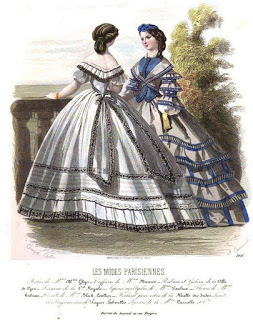 September 1862 fashions
September 1862 fashions
Clicking on the image will enlarge it. Clicking on the caption will take you to the source, where you can learn more and enlarge images as needed.
Published on September 14, 2017 21:30
September 13, 2017
Shameless Self-Promotion: The First Booksigning for I, ELIZA HAMILTON Is Saturday, September 16
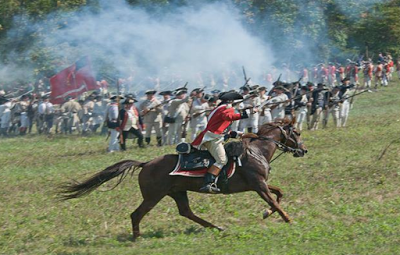
Susan reporting,
Writing a book seems to take forever, and the production - the edits, and rewrites, and galleys, and approving this and that and more - seems to take even longer. And then, suddenly, it's publication day, and your darling is thrust out into the world.
OK, that's melodramatic, but at last it's that time for I, ELIZA HAMILTON , which will be available everywhere on September 26. If you'll be in the Philadelphia area this weekend, however, you'll be able to get your copy early at a very special booksigning at Sandy Hollow Heritage Park , Birmingham Township, PA.
What makes this booksigning special is that it will be part of Brandywine2017, a weekend-long re-enactment and celebration to mark the 240th anniversary of the Battle of Brandywine. (See my earlier blog posts about the battle here and here .) Fought on September 11, 1777, Brandywine was the largest land battle of the American Revolution, with approximately 26,000 combatants. George Washington commanded the Continental Army, and General William Howe led the British. The names of those on the field included many who would become well known in American history: the Marquis de Lafayette, generals Nathaniel Greene, Anthony Wayne, and Henry Knox, future President James Monroe, and future Supreme Court Chief Justice John Marshall.
Oh, and there was also another young officer at the battle, serving as one of General Washington's aides-de-camp, who would one day become the first Secretary of the Treasury: Lt. Col. Alexander Hamilton. Can you understand now why I wanted this to be my first booksigning for I, ELIZA HAMILTON?
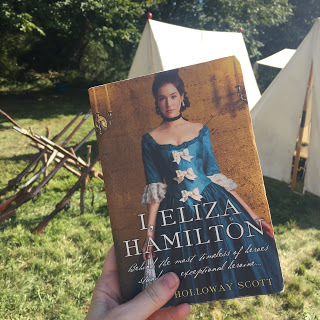
Nearly a thousand uniformed Revolutionary War re-enactors will gather from around the country to recreate the battle, fighting on the same fields and farmland as the original battle more than two centuries ago. There will infantry, cavalry, and dragoons, artillery demonstrations and military music.
Before and after the "battles" (the British will win on Saturday, but the Americans will triumph on Sunday), visitors will be able to tour the encampments and meet the re-enactors, and step inside the handsewn replica of Washington's campaign headquarters tent. There will also be 18thc-style wares offered for sale by dozens of vendors and sutlers, as well as other authors, offering fiction, non-fiction, and children's books, all with a Revolutionary War connection.
Perhaps best of all, the event is free, with plenty of free parking. Check out the the Brandywine2017 website for all the details, including directions.
I'll be signing I, ELIZA HAMILTON on Saturday, September 16, from 11:00 am-1:00 pm, in the author tent near the entrance. Hope to see you there - please introduce yourself!
Published on September 13, 2017 18:32
September 10, 2017
A Rare Maternity Ensemble, c1780-95
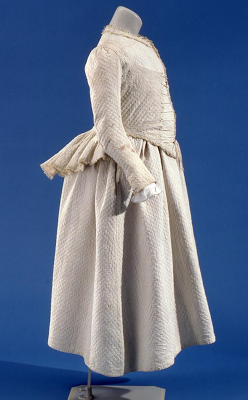 Susan reporting,
Susan reporting,A near-constant cycle of childbearing and nursing children was one of the realities of married life for most 18thc European and American women. Elizabeth Schuyler Hamilton (1757-1854), the heroine of my new book I, Eliza Hamilton , was typical. Over the course of her twenty-three-year marriage to Alexander Hamilton, she was pregnant nine times, miscarried once, and bore eight children. She was much more fortunate than many of her contemporaries; all the Hamilton children survived to adulthood. Her mother, Catherine Van Rensselaer Schuyler (1734-1803) was sadly more typical: she bore fifteen children, seven of whom died as infants.
Yet very little 18thc maternity clothing survives. There are several reasons for this: utilitarian clothing is much more rare, simply because it was worn until it was worn out. It wouldn't have been set aside and preserved the way that, say, an elaborate dress created for an elite woman for a court appearance might have been. Everyday clothing was refashioned and cut apart, remade and reused until, literally, nothing remained.
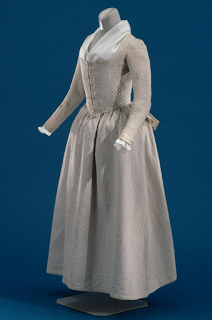
Because textiles were expensive and valued, most women would not have owned garments that were designated exclusively as "maternity." Instead their ordinary clothing would simply be adapted to their changing figures. The drawstrings that formed the waistlines in petticoats (skirts) were let out. The front-closing bodices were usually held together by straight pins instead of buttons or other closures, and could easily be re-pinned to accommodate a changing figure. Triangular inserts called stomachers could be used to fill the widening space left in between, and adjustable lacings were another practical design feature. Other popular garments, like the t-shaped bedgowns, were sufficiently loose-fitting for pregnancy and nursing. The front-opening styles with deep necklines, in fashion for most of the 18thc, were also easily adapted for nursing mothers.
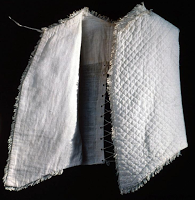
This rare three-piece ensemble from the collection of Colonial Williamsburg was likely designed by a woman (and her mantua-maker) for her own use before, during, and after pregnancy. Cut from a diamond-quilted white cotton bed quilt, the old quilt's edging pattern was cleverly aligned to form an undulating border design along the hem of the petticoat. The drawstring at the petticoat's waist could easily expand, and would have been worn above the "baby bump."
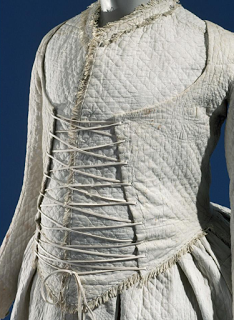
It's also likely that the fashionable mother-to-be wore the petticoat over a padded false bum for extra volume in the back of her skirts, and that she continued to wear her stays (corset) beneath an ensemble like this one. Most 18thc stays laced up the back, and the two sides were never intended to meet. During pregnancy, the lacing was simply widened to allow more space. As always, the goal in the 18thc was not to achieve a tiny waist through tight lacing (as in the 19thc), but to maintain an erect posture and to create a silhouette that featured a straight front and narrow back. I'm sure most pregnant women skipped their stays while at home, but there were probably others who welcomed the familiar support that their stays offered.
The jacket with its stylish back peplum and fringed trim closed with a zig-zagging cord at the center front. For non-pregnancy wear, upper right, the front edges were laced together to meet at the front, but as the woman's pregnancy progressed, the third piece of the ensemble, a sleeveless undervest, would have been worn beneath the jacket, lower right. The vest, middle left, was not only cut widely for a pregnant body, but also had a slit in the back like a man's waistcoat, adjustable with more lacing. The jacket's front lacings could have been widened, with the vest beneath filling in the now-open front. The layers would also provided welcome warmth - always a plus in drafty 18thc houses.
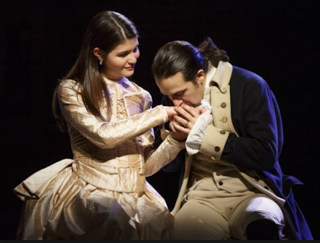
While there are no records or contemporary descriptions of how Eliza Hamilton dressed during her pregnancies, I imagine that she, too, wore adaptable garments such as these, and that's how I described them in I, Eliza Hamilton. I suspect I'm not the only one inspired by this ensemble, either. The costume that's worn by the pregnant Eliza (played by Philippa Soo, and shown bottom left with Lin-Manuel Miranda as Alexander) in the musical Hamilton looks so much like the Colonial Williamsburg ensemble that I have to think the show's designer Paul Tazewell was aware of it, too.
Many thanks to Neal Hurst, associate curator of costumes and textiles, Colonial Williamsburg, for his assistance with this post.
Above: Women's quilted maternity ensemble, c1780-1795, collection of Colonial Williamsburg.
Published on September 10, 2017 17:00
September 9, 2017
Breakfast Links: Week of September 4, 2017
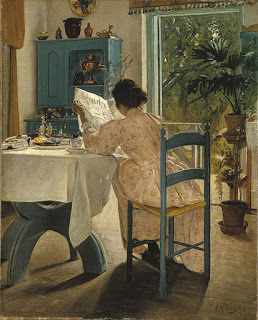 Breakfast Links are served - our weekly round-up of fav links to other web sites, articles, blogs, and images via Twitter.
Breakfast Links are served - our weekly round-up of fav links to other web sites, articles, blogs, and images via Twitter.• Confessions of a costume curator : what it's like to learn from dead people's clothing for a living.
• The forgotten history of black chefs .
• How to get breasts like apples : beauty hints for the early modern woman.
• Forgotten victims of the French Revolutionary Wars: nearly 2,000 black & mixed race men, women, & children from the Caribbean were held as prisoners at Portchester Castle in Hampshire, England.
• The United Palace Theater , a magnificent Jazz Age movie palace in New York City still hosts live performances.
• Image: Mourning brooch of a deceased young man, c1860.
• Tourist trinkets: the medieval pilgrimage badge .
• You'll never be as radical as Benjamin Lay , an 18thc Quaker dwarf.
• Knitting for victory: crafty women and the Great War.
• The great Eclipse - the one that left his mark on the equine world in the 18thc.
• Video: An elaborate traveling chest that contains tea-making equipment once belonged to Napoleon's daughter.
• Emma Snodgrass, arrested in Boston in 1852 for wearing trousers.
• Slow-churn democracy: ice cream in 18th-19thc America.
• Archaeologists determine how castration affected the growth and skeleton of famous 18thc opera singer Farinelli .
• Images: Andrew Jackson's coach, from his home, The Hermitage.
• Treasonous magic in medieval and early modern England.
• A c1876 scrapbook of sentimental memorabilia with hand-embroidered details.
• The limits of preservation and restoration (includes the 17thc Salem Witch House.)
• Image: Parasol with steel mesh lining to protect Queen Victoria from assassin's bullets.
Hungry for more? Follow us on Twitter @2nerdyhistgirls for fresh updates daily.
Above: At Breakfast by Laurits Andersen Ring. Private collection
Published on September 09, 2017 14:00
September 7, 2017
Friday Video: Dressing an 18thc Lady
Susan reporting:
This recent video from the Lady Lever Art Gallery and National Museums of Liverpool has been popular on social media, but it's so well-done that I'm sharing it here, too.
A few things to keep in mind as you watch. The video is recreating the routine of an elite woman. With two maidservants to assist her, the mannered ritual of dressing is part of the luxury of the woman's fashionable (and costly) clothing. The time she spends being dressed - for she's remarkably passive in the process - reflects the leisure of her rank, and the entire process could be repeated during the course of a day. She might first be dressed in a riding habit in the morning, changed into a gown to receive friends at home for tea, and then again dressed into a more formal ensemble for the theatre or a ball, before finally being undressed for bed.
The two maidservants are much more representative of what the majority of 18thc European and American women wore - and yet their clothing is not significantly less complicated. They're also wearing shifts, stays, petticoats, pockets, stockings, stomachers, aprons, kerchiefs, and caps. With less time at their disposal, however, they would have learned to dress themselves much more quickly than their fashionably idle mistress.
Remember, too, that privacy is a modern concept, and that few 18thc women would have had a room to themselves. There would likely have been a mother, sister, or fellow servant nearby to help tie the laces on stays snug, or adjust the back of a cap. Practice makes perfect, and efficiency as well: women who dressed like this every day of their lives would have the routine down. I've watched some of my friends from Colonial Williamsburg - who wear 18thc clothing on a daily basis - and they dress with surprising speed.
If you received this post via email, you may be seeing a black box or empty space where the video should be. Click here to view the video.
Published on September 07, 2017 19:15
September 5, 2017
Brave Peggy Schuyler, 1781
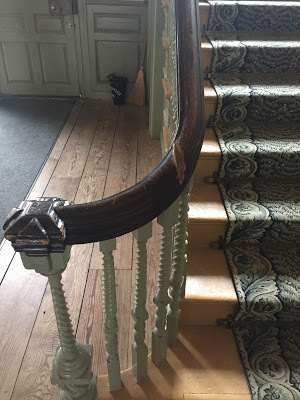 Susan reporting,
Susan reporting,As much as I love reading about history, there are times when the tangible scars of a long-ago incident are infinitely more memorable than a thousand written words. A long time ago (oh, in the last century or so), when I was still in elementary school, my parents took me to Historic Deerfield as part of a family vacation. All the details of that trip are long gone from my memory except for one incredibly powerful object: the " Old Indian House Door " from the 17thc Capt. John Sheldon House.
The door survived the infamous 1704 Deerfield Raid by the French and their Native American allies, a massacre that killed fifty English men, women, and children, made captives of dozens of others, and left the town in ruins. The Sheldon House door stands as a mute testament to that harrowing day, with its broad beams hacked to form a ragged hole through which the French fired their muskets on the inhabitants. I recall the door being displayed complete with a tomahawk in place, but I might be imagining that. In any event, the door fed my nightmares for years. Still does.
That door has yet to appear in any of my books, but I thought of it immediately while I was researching my new historical novel, I, Eliza Hamilton . I've written before about the Schuyler Mansion, the house in which my heroine Eliza Schuyler Hamilton was raised ( here , here , here , and here .) Originally known as The Pastures in the 18thc, the elegant brick mansion was surrounded by a large estate that overlooked the Hudson River.
But even The Pastures didn't entirely escape the American Revolution. Gen. Philip Schuyler, Eliza's father, first served in the Continental Army, and later in the war continued to advise his close friend Commander-in-Chief General George Washington. By the summer of 1781, the majority of the fighting had moved south, but the general's importance still made him a target to the enemy, and a small group of soldiers was assigned to the house to guard the general and his family. At the time, this included not only his wife Catharine and their younger children, but also his two older, married daughters, Angelica Church and Eliza Hamilton (both of whom were pregnant and visiting while their husbands were with the army), and Angelica's two children.
On a warm evening in August, the house was attacked by a group of local Tories and Native Americans. While the guards attempted to fight them off, the family fled upstairs to barricade themselves in one of the bedchambers until help arrived. Too late Catharine Schuyler realized to her horror that her youngest child, a baby also named Catherine, had been left asleep downstairs.
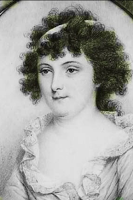
Bravely - or impulsively - the third daughter, twenty-two-year-old Margarita (better known as Peggy, and shown right in a later portrait) raced back downstairs to rescue her baby sister. Challenged by the attackers who were now ransacking the house, Peggy thought quickly, and told them that armed reinforcements were on the way from the town. As she raced up the stairs with her sister in her arms, one of the attackers swung a tomahawk at her, catching her skirts and and hacking a deep gouge into the banister. Soon afterward, reinforcements did indeed arrive, the general and his family were saved, and Peggy was lauded as a heroine.
Today some of the details of the attack are suspected to have been 19thc embellishments. But there's no doubt that the raw tomahawk gouge remains in the banister, above left, carefully preserved over the centuries as proof. As I ran my fingers over it, I couldn't help but picture brave Peggy Schuyler, her skirts flying and her baby sister wailing, as she faced down the enemy who'd dared attack her home.
Left: Photograph of the Schuyler Mansion staircase, ©2017 Susan Holloway Scott.
Right: Photograph detail of a miniature portrait of Magarita Schuyler Van Rensselaer by James Peale, c1796.
Published on September 05, 2017 18:48
August 23, 2017
Gone Fishin'
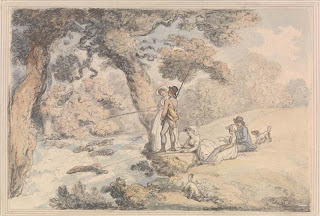 Rowlandson, The Angling Party
Susan and Loretta report:
Rowlandson, The Angling Party
Susan and Loretta report:Yes, it seems like only yesterday we took a break, but now it's family time—at the beach, away from social media (well, mostly).
One of us will be back sooner than the other, but we'll both be back in a few weeks.
Meanwhile, we hope you, too, will make the most of these last weeks of summer (or winter, if you are in the other hemisphere).
See you in September!
Image: Thomas Rowlandson, The Angling Party , courtesy Yale Center for British Art, Paul Mellon Collection.
Clicking on the image will enlarge it. Clicking on the caption will take you to the source, where you can learn more and enlarge images as needed.
Published on August 23, 2017 21:30
August 21, 2017
Turnpike Gates Demolished
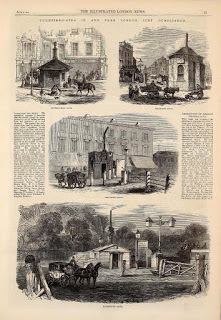 Turnpike Gates
Loretta reports:
Turnpike Gates
Loretta reports:Some while ago, I reported my surprise at learning the Hyde Park Corner Tollgate was taken down as early as 1825. It was one of numerous traffic-slowing structures on the London roads, like Temple Bar (but more of that anon).
During my visit to the London Transport Museum , some clippings from the Illustrated London News gave me another little surprise: Hyde Park Corner Toll-gate might have gone away in the 1820s, but the majority of turnpike gates stayed in place for a long time afterward, in spite of decades of complaints, until the 1860s.
DEMOLITION OF LONDON TURNPIKE GATES.Clicking on the image will enlarge it. Clicking on the caption will take you to the source, where you can learn more and enlarge images as needed.
This week has witnessed the abolition of turnpike toll obstructions upon fifty miles of road in and about London on the Middlesex side of the Thames. It was many years ago that the agitation for air removal commenced, and the Illustrated London News then took the lead in advocating this important matter of social and economical reform. We have therefore thought it worth while to engrave Sketches of some of the tollgates which have been so familiar to every Londoner's eye. and which, having partly disappeared in the last few weeks, are henceforward to be utterly demolished. The City-road gate and the Islington gate, which were situated amidst a dense population, with the gates of Kensington and Notting-hill, which barred free communication with the western suburbs and villages beyond, have been selected for these Illustrations. Under the “Metropolis Turnpike. Road Act Amendment" (which takes effect from the 1st of July), twenty-five toll-gates and fifty-six side bars are done away with. At Fulham. including Walham-green and Earl's Court, all the gates and side bans are removed; also at Kensington, Hammersmith, Notting-hill, Harrow-road, Kilburn, and Camden Town, the latter comprising the King's-road gate, High-street, Chalk Farm, and the Brecknock gate, as well as the gate in the road at Kentish Town. Further removals take place at Holloway, Islington, Ball’s Pond, Kingsland-road, Cambridge-heath, Hackney, Twickenham, and Teddington. All the gates and side bars of the city-road are included. We congratulate the whole metropolis upon the abatement of this nuisance, and hope soon to record its total extirpation on the Surrey as well as the Middlesex side of the river.—The Illustrated London News, 2 July 1864
Published on August 21, 2017 21:30
August 20, 2017
The "Keenest Sorrows" in August, 1804, After Alexander Hamilton's Death
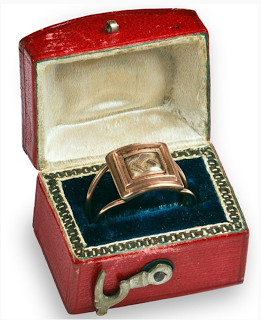 Susan reporting,
Susan reporting,One of the more interesting books that I discovered in my research for my new book I, Eliza Hamilton was a solemn compendium with a monumental title: A Collection of the Facts and Documents, Relative to the Death of Major-General Alexander Hamilton: With Comments: Together with the Various Orations, Sermons, and Eulogies, that Have Been Published Or Written on His Life and Character.
Published not long after Alexander Hamilton died from wounds incurred in his infamous duel with Aaron Burr in July, 1804, the book is exactly what that title says it is. Today's publishers often rush such titles to press to cash in on a topical event, usually branding them as "special souvenir collector's editions" and the like, but in 1804, this was unusual. Then again, the circumstances were unusual, too. The country - and particularly Hamilton's hometown of New York City - were stunned by news of a duel between the former Secretary of the Treasury and the current Vice President, and shocked by Hamilton's subsequent death.
The outcry was immediate. Even those who didn't fault Burr and felt that duels of honor still had their place between gentlemen (the practice was already illegal in New York), no one could deny the tragic waste of Hamilton's life, or the terrible effect his death had on his widow and young family. Charges of murder were filed against Burr, who had fled New York for the more sympathetic southern states. The city of New York was plunged into official, black-draped mourning. More pointedly, ministers deplored the sinful practice of dueling from their pulpits.
A Collection....was assembled by William Coleman, a former lawyer (and former law partner of Aaron Burr) who had been chosen by Hamilton in 1801 to be the editor of the Federalist newspaper, The New York Evening Post. Coleman himself was no stranger to duels; earlier in 1804, he had killed a man in a duel over a dispute with a rival newspaper.
Nor was Coleman an impartial editor. In the preface, he described Hamilton as "my best earthly friend, my ablest adviser, and my most generous and disinterested patron." He quickly put together the collection both as a tribute to Hamilton, and a defense of his friend's actions relating to the duel, and the book was published before the end of the year. A 1904 edition of A Collection.... is available to read for free online here .
One article in particular - from the August 29, 1804 edition of The Albany Centinel - touched me the most since it focussed on Eliza. Immediately following her husband's death, Eliza was so distraught that friends and family feared for her sanity. She did not attend the funeral, and soon retreated with her daughters and younger sons to her father's house in Albany. Yet by the end of August, she must have been beginning to appear again in public - though as this excerpt shows, her grief was clearly still painfully raw.
"On Sunday morning the afflicted Mrs. HAMILTON attended divine service in the Presbyterian Church in this city, with her three little sons [I'm guessing that this must have been her youngest sons, John Church, 12, William Stephen, 7, and Little Phil, 2.]
"At the close of a prayer by the Rev. Mr. Nott, the eldest boy dropped on his face, in a fainting fit.
"Two gentlemen immediately raised him, and while bearing him out of the church, the afflicted mother sprung forward, in the agonies of grief and despair, towards her apparently lifeless son.
"The heart-rending scenes she had recently struggled with, called forth all the fine-spun sensibilities of her nature – and seemed to say, that nature must, and will be indulged in her keenest sorrows – She was overpowered in the conflict, and likewise sunk – uttering such heart-rending groans, and inward sighs, as would have melted into mingled sympathies, even Burr himself.
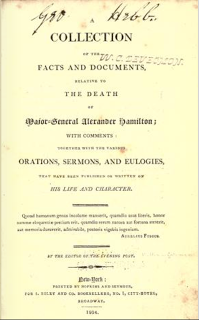
"Both of them soon recovered – and while the little son was supported standing on the steps, yet speechless, the most affecting scene presented itself – a scene, could it be placed on canvas by the hand of a master, would be in the highest degree interesting and impressive. The mother, in this tender situation, fastened herself upon the son, with her head reclining on his left shoulder – the agonies so strongly painted on her countenance – her long flowing weeds – the majesty of her person – the position of both – and above all, the peculiarity of their trying situation in the recent loss of a husband, and a father – who could refrain from invoking on the head of the guilty author of their miseries, those curses he so rightly merits? The curse of living despised, and execrated by the voice of a whole nation – the curse of being held up to the view of future ages – a MONSTER, and an ASSASSIN."
Poor Eliza!
Above: Gold mourning ring, containing the braided hair of Gen. Alexander Hamilton, presented to a friend of Hamiltons by his wife in 1805. New-York Historical Society.
Below: Title page, A Collection of the Facts and Documents, Relative to the Death of Major-General Alexander Hamilton.... New York: Printed by Hopkins & Seymour for I. Riley & Co, 1804. Collection, University of California Libraries.
Published on August 20, 2017 18:08
The "Keenest Sorrows" After Alexander Hamilton's Death, 1804
 Susan reporting,
Susan reporting,One of the more interesting books that I discovered in my research for my new book I, Eliza Hamilton was a solemn compendium with a monumental title: A Collection of the Facts and Documents, Relative to the Death of Major-General Alexander Hamilton: With Comments: Together with the Various Orations, Sermons, and Eulogies, that Have Been Published Or Written on His Life and Character.
Published not long after Alexander Hamilton died from wounds incurred in his infamous duel with Aaron Burr in July, 1804, the book is exactly what that title says it is. Today's publishers often rush such titles to press to cash in on a topical event, usually branding them as "special souvenir collector's editions" and the like, but in 1804, this was unusual. Then again, the circumstances were unusual, too. The country - and particularly Hamilton's hometown of New York City - were stunned by news of a duel between the former Secretary of the Treasury and the current Vice President, and shocked by Hamilton's subsequent death.
The outcry was immediate. Even those who didn't fault Burr and felt that duels of honor still had their place between gentlemen (the practice was already illegal in New York), no one could deny the tragic waste of Hamilton's life, or the terrible effect his death had on his widow and young family. Charges of murder were filed against Burr, who had fled New York for the more sympathetic southern states. The city of New York was plunged into official, black-draped mourning. More pointedly, ministers deplored the sinful practice of dueling from their pulpits.
A Collection....was assembled by William Coleman, a former lawyer (and former law partner of Aaron Burr) who had been chosen by Hamilton in 1801 to be the editor of the Federalist newspaper, The New York Evening Post. Coleman himself was no stranger to duels; earlier in 1804, he had killed a man in a duel over a dispute with a rival newspaper.
Nor was Coleman an impartial editor. In the preface, he described Hamilton as "my best earthly friend, my ablest adviser, and my most generous and disinterested patron." He quickly put together the collection both as a tribute to Hamilton, and a defense of his friend's actions relating to the duel, and the book was published before the end of the year. A 1904 edition of A Collection.... is available to read for free online here .
One article in particular - from the August 29, 1804 edition of The Albany Centinel - touched me the most since it focussed on Eliza. Immediately following her husband's death, Eliza was so distraught that friends and family feared for her sanity. She did not attend the funeral, and soon retreated with her daughters and younger sons to her father's house in Albany. Yet by the end of August, she must have been beginning to appear again in public - though as this excerpt shows, her grief was clearly still painfully raw.
"On Sunday morning the afflicted Mrs. HAMILTON attended divine service in the Presbyterian Church in this city, with her three little sons [I'm guessing that this must have been her youngest sons, John Church, 12, William Stephen, 7, and Little Phil, 2.]
"At the close of a prayer by the Rev. Mr. Nott, the eldest boy dropped on his face, in a fainting fit.
"Two gentlemen immediately raised him, and while bearing him out of the church, the afflicted mother sprung forward, in the agonies of grief and despair, towards her apparently lifeless son.
"The heart-rending scenes she had recently struggled with, called forth all the fine-spun sensibilities of her nature – and seemed to say, that nature must, and will be indulged in her keenest sorrows – She was overpowered in the conflict, and likewise sunk – uttering such heart-rending groans, and inward sighs, as would have melted into mingled sympathies, even Burr himself.

"Both of them soon recovered – and while the little son was supported standing on the steps, yet speechless, the most affecting scene presented itself – a scene, could it be placed on canvas by the hand of a master, would be in the highest degree interesting and impressive. The mother, in this tender situation, fastened herself upon the son, with her head reclining on his left shoulder – the agonies so strongly painted on her countenance – her long flowing weeds – the majesty of her person – the position of both – and above all, the peculiarity of their trying situation in the recent loss of a husband, and a father – who could refrain from invoking on the head of the guilty author of their miseries, those curses he so rightly merits? The curse of living despised, and execrated by the voice of a whole nation – the curse of being held up to the view of future ages – a MONSTER, and an ASSASSIN."
Poor Eliza!
Above: Gold mourning ring, containing the braided hair of Gen. Alexander Hamilton, presented to a friend of Hamiltons by his wife in 1805. New-York Historical Society.
Below: Title page, A Collection of the Facts and Documents, Relative to the Death of Major-General Alexander Hamilton.... New York: Printed by Hopkins & Seymour for I. Riley & Co, 1804. Collection, University of California Libraries.
Published on August 20, 2017 18:08



